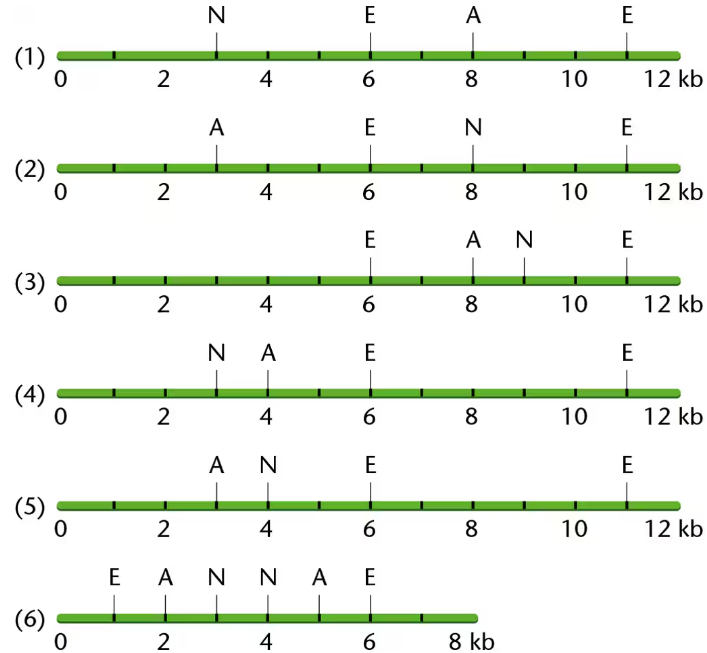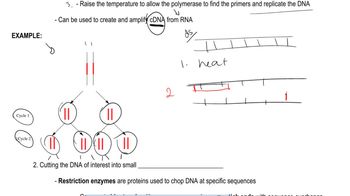Vitamin E is the name for a set of chemically related tocopherols, which are lipid-soluble compounds with antioxidant properties. Such antioxidants protect cells against the effects of free radicals created as by-products of energy metabolism in the mitochondrion. Different tocopherols have different biological activities due to differences in their retention by binding to gut proteins during digestion. The one retained at the highest level is α-tocopherol, whereas γ-tocopherol is retained at less than 10% of that efficiency. In Arabidopsis, α-tocopherol is the most abundant tocopherol in leaves, whereas γ-tocopherol is the most abundant in seeds. An enzyme encoded by the VTE4 gene can convert γ-tocopherol to α-tocopherol. How would you create an Arabidopsis plant that produces high levels of α-tocopherol in the seeds?
Table of contents
- 1. Introduction to Genetics51m
- 2. Mendel's Laws of Inheritance3h 37m
- 3. Extensions to Mendelian Inheritance2h 41m
- 4. Genetic Mapping and Linkage2h 28m
- 5. Genetics of Bacteria and Viruses1h 21m
- 6. Chromosomal Variation1h 48m
- 7. DNA and Chromosome Structure56m
- 8. DNA Replication1h 10m
- 9. Mitosis and Meiosis1h 34m
- 10. Transcription1h 0m
- 11. Translation58m
- 12. Gene Regulation in Prokaryotes1h 19m
- 13. Gene Regulation in Eukaryotes44m
- 14. Genetic Control of Development44m
- 15. Genomes and Genomics1h 50m
- 16. Transposable Elements47m
- 17. Mutation, Repair, and Recombination1h 6m
- 18. Molecular Genetic Tools19m
- 19. Cancer Genetics29m
- 20. Quantitative Genetics1h 26m
- 21. Population Genetics50m
- 22. Evolutionary Genetics29m
18. Molecular Genetic Tools
Genetic Cloning
Problem 30
Textbook Question
A widely used method for calculating the annealing temperature for a primer used in PCR is 5 degrees below the melting temperature, Tₘ(°C), which is computed by the equation 81.5+0.41×(%GC)−(675/N), where %GC is the percentage of GC nucleotides in the oligonucleotide and N is the length of the oligonucleotide. Notice from the formula that both the GC content and the length of the oligonucleotide are variables. Assuming you have the following oligonucleotide as a primer,
5′-TTGAAAATATTTCCCATTGCC-3′
Compute the annealing temperature for PCR. What is the relationship between %GC and? Why? (Note: In reality, this computation provides only a starting point for empirical determination of the most useful annealing temperature.)

 Verified step by step guidance
Verified step by step guidance1
First, determine the length (N) of the oligonucleotide by counting the total number of nucleotides in the sequence 5′-TTGAAAATATTTCCCATTGCC-3′.
Next, calculate the %GC content by counting the number of guanine (G) and cytosine (C) nucleotides in the sequence, then divide by the total length (N) and multiply by 100 to get the percentage.
Use the given formula for melting temperature (Tₘ): to calculate Tₘ by substituting the values of %GC and N.
Calculate the annealing temperature by subtracting 5 degrees Celsius from the melting temperature: .
Understand the relationship between %GC and melting temperature: higher %GC increases Tₘ because G-C pairs form three hydrogen bonds, making the DNA more stable and harder to denature, whereas A-T pairs have only two hydrogen bonds.
 Verified video answer for a similar problem:
Verified video answer for a similar problem:This video solution was recommended by our tutors as helpful for the problem above
Video duration:
1mPlay a video:
Was this helpful?
Key Concepts
Here are the essential concepts you must grasp in order to answer the question correctly.
Melting Temperature (Tₘ) of DNA Primers
The melting temperature (Tₘ) is the temperature at which half of the DNA duplex dissociates into single strands, indicating primer stability. It depends on the primer's nucleotide composition, especially GC content, and length. Accurate Tₘ calculation is crucial for setting the annealing temperature in PCR to ensure specific binding.
Recommended video:
Guided course

Steps to DNA Replication
GC Content and Its Effect on DNA Stability
GC content refers to the percentage of guanine and cytosine bases in a DNA sequence. GC pairs form three hydrogen bonds, compared to two in AT pairs, making GC-rich regions more thermally stable. Higher %GC increases the melting temperature, influencing primer binding strength during PCR.
Recommended video:
Guided course

Maternal Effect
Annealing Temperature in PCR
Annealing temperature is the temperature at which primers bind to the target DNA during PCR. It is typically set a few degrees below the primer's Tₘ to promote specific hybridization. Correct annealing temperature balances primer binding efficiency and specificity, affecting PCR success.
Recommended video:
Guided course

Genetic Cloning
Related Videos
Related Practice
Textbook Question
446
views


